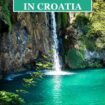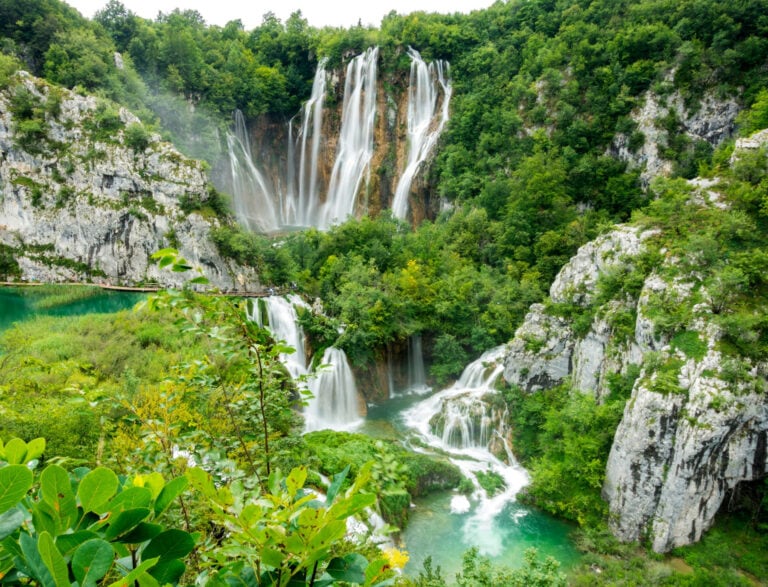
If you think of Croatia, you probably think of the Adriatic coast rather than waterfalls. This is understandable given that Croatia is so focused on sea tourism. Even the majority of Croatians are unaware of some of our most beautiful waterfalls in their country. I think it’s time to change that.
Croatia is in Central Europe, bordering Slovenia, Hungary, Serbia, Bosnia and Herzegovina, Montenegro and Italy. Its clear sea, sunny coasts and abundance of natural beauty make it one of Europe’s most popular summer vacation spots.
In terms of water wealth, Croatia is the fifth-richest country in Europe. Although you are unlikely to visit it solely for the waterfalls, consider including at least one in your day-trip itinerary. I promise you won’t regret it.
Veliki Slap, Plitvice Lakes National Park
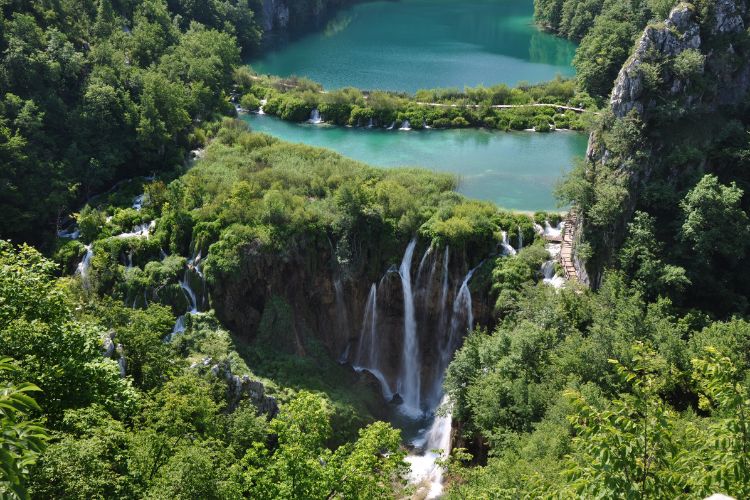
If you only visit one national park in Croatia, make it the Plitvice National Park (ok, consider Brijuni too).
Some Croatian nature lovers would argue that we have other beautiful national parks, which we certainly do. However, if you ask me, there is a good reason why our largest national park is so popular.
CNN named it the world’s third-most beautiful waterfall, UNESCO designated it a UNESCO World Heritage Site and the Daily Mail compared it to an island you wouldn’t believe existed. All of this contributed to Plitvice becoming one of Europe’s most famous waterfalls, with over a million visitors each year.
This stunning scene consists of 16 lakes, divided into upper and lower sections (Gornji Slapovi and Donji Slapovi) with the Veliki Slap waterfall as the main attraction.
Veliki Slap is not only the highest waterfall in the Plitvice Lakes, but also the highest in Croatia. A spectacular welcome awaits you at the park’s first entrance: water falls from a height of 87 meters over a steep cliff and flows into the lower lakes, where it merges with the second waterfall on this list.
Sastavci Waterfalls, Plitvice Lakes National Park

When the water of the Great Fall (Veliki Slap) flows into the lower lakes, it creates the stunning Sastavci.
After 150 meters, water descends the travertine barrier. As stated on the Plitvice plaque, ‘travertine is a hollow rock that is formed by the precipitation of calcium carbonate dissolved in water with the help of plants, algae, and mosses’.
When the Veliki Slap and Sastavci Waterfalls meet, the Korana River is formed. Really, have you ever seen a river with a more beautiful source? Okay, maybe (just maybe) the Cetina River?
Book Your Plitvice Lakes National Park Admission Ticket
Kotli Waterfall
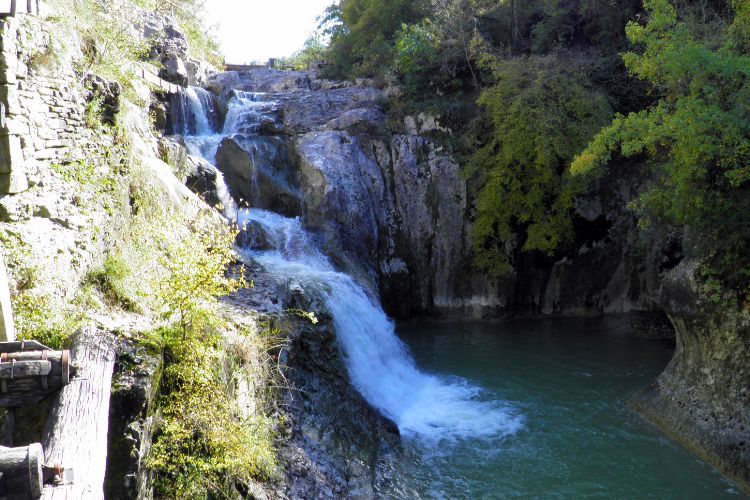
Did you know that Croatia is home to the smallest city in the world? Its name is Hum, and it’s close to Kotli Waterfall. Many people associate Kotli with the popular Turkish tourist destination Pamukkale because Kotli is known for its natural “pools” of white limestone filled with turquoise waters.
Another distinguishing feature of Kotli Waterfall is that it feels like time has stood still; the houses are uninhabited and date back to the 18th century. You’ll also notice a small watermill, the last of 60, that is still operational.
I suggest trying the local cuisine while you’re there (anything with truffles). After that, you can burn off the excess calories by cycling, exploring hiking trails, paragliding or horseback riding. Or just add dessert, whatever you prefer.
This beautiful place is in Istria, a popular Adriatic destination that is easy to include in your itinerary.
Just keep in mind that the pools’ water may evaporate during the summer. It wouldn’t be nice to be greeted by empty pools, would it?
Velike Kaskade, Plitvice National Park
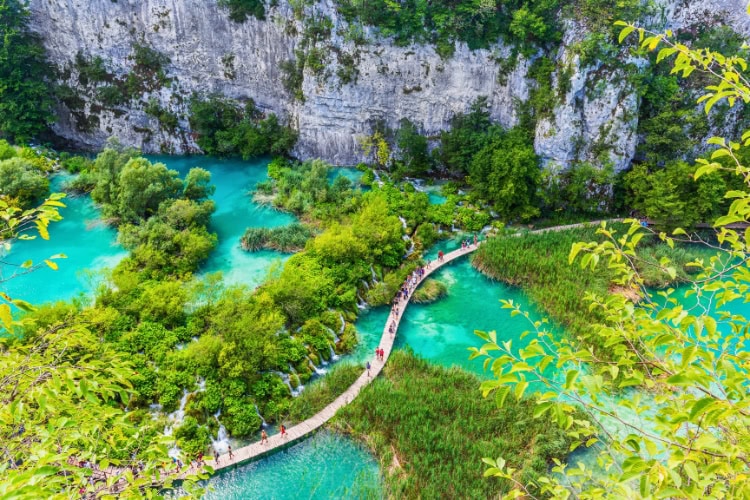
Velike Kaskde, with its turquoise lake, wooden walkway, bubbling cascades and lush vegetation, is one of Plitvice National Park’s most photographed locations. When you see it you’ll understand why.
Also, do you know how Plitvice National Park was formed?
According to legend, this beautiful place was a result of the heavy rain. The area experienced such a severe drought that people began to beg for rain. Their request was granted, but the rain did not stop, and water began to flow over the cliff from Lake Galovac.
So people began praying for the rain to stop. And the rain, well, stopped.
And that’s how we got Plitvice National Park. Is it really so simple?
Skradinski Buk, Krka National Park
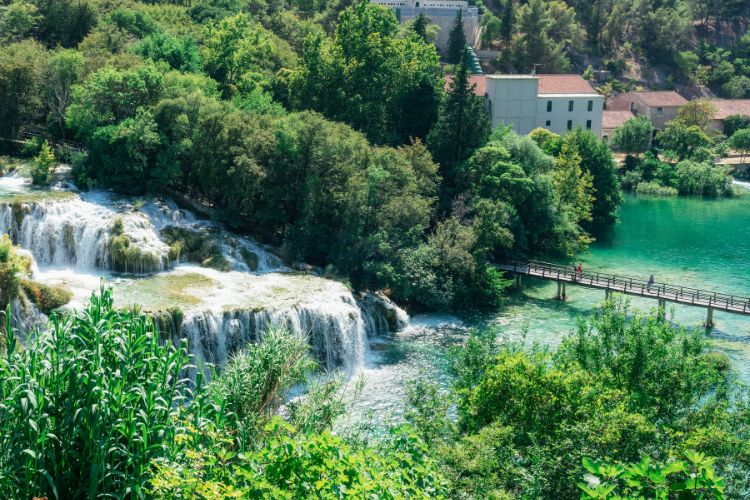
Can you believe that the hydroelectric power plant here on the Krka River is almost the world’s oldest?
It was surpassed by just two days when Tesla’s hydroelectric power plant in Niagara Falls opened on August 26, 1895. It is also interesting to note that Nikola Tesla was born in Croatia, in the village of Smiljan in Lika.
The mentioned Jaruga, which he took the title from, opened on August 28, 1895, and is the oldest in Europe and the second oldest in the world.
But let’s return to Skradinski Buk, the most popular waterfall on the Krka River. Located near Skradin, it is made up of 17 steps that span 800 meters and flow into the lake from a height of 45 meters.
There is a bridge across the lake that offers a nice view, and the lake is popular for swimming. So, if you’ll be near Split in the summer, treat yourself to a one-of-a-kind experience of swimming under one of the best waterfalls in Croatia.
Split to Krka Waterfalls Tour, Boat Cruise and Swimming
Galovački Buk, Plitvice Lakes National Park
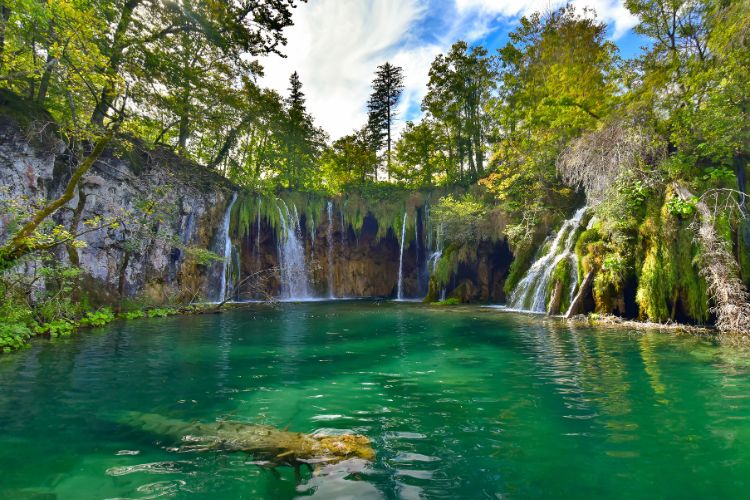
The 300-square-meter Plitvice National Park is home to Galovački Buk, one of the most beautiful and photogenic Croatian waterfalls.
It is located in the Upper Lakes, where the waters of Lake Milino and Lake Galovac flow from a 16-meter height into Lake Gradinsko.
By the way, did you know Plitvice National Park is Croatia’s oldest national park?
Rastoke Waterfalls
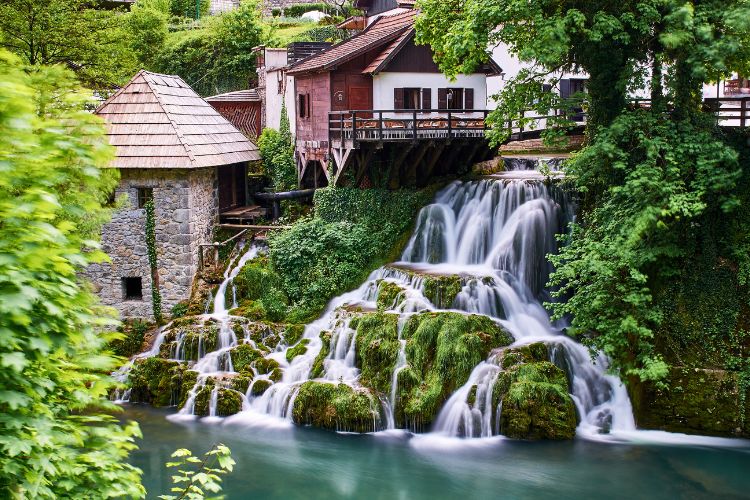
Also known as “Little Plitvice,” these falls are located next to Slunj, only 33 kilometers from the real Plitvice. Rastoke Waterfalls are a meeting point of the Slunjčica and Korana rivers.
This beautiful place is known for its watermills (built in the 17th century) that were powered solely by water. Since we humans are also driven by food, try the local cuisine at the “Pod Rastočkim krovom” tavern. The combination of the delicious food, natural beauty and the wooden terrace over the water makes this lunch a memorable experience.
Also, here’s an interesting fact: according to legend, fairies used to visit Rastoke Waterfalls at night.
While the millers were talking by the fire, the fairies would sneakily borrow horses, returning them by dawn exhausted and with their manes braided.
So, it’s not so strange that one of Rastoke’s waterfalls resembles long, lush hair and is called Fairy’s Hair.
Štrbački Buk
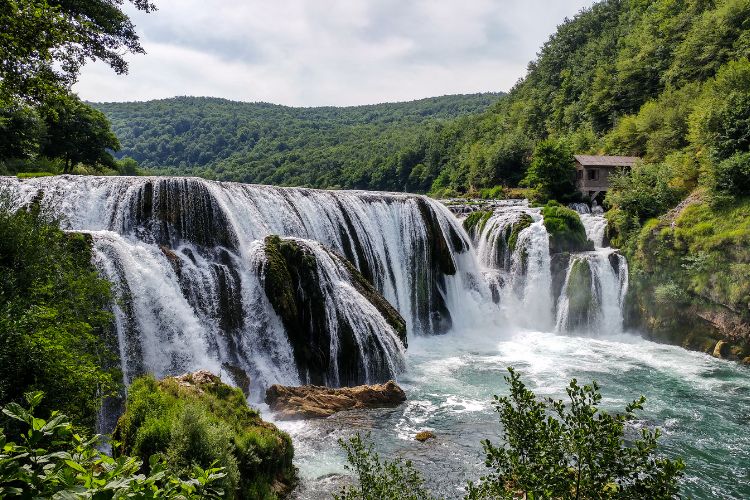
“One” and “only”—that’s what the name of the Una River means. Štrbački Buk, one of the most beautiful waterfalls on this list, is located on this river, on the Croatian and Bosnian border.
It is nearly 25 meters tall and widely regarded as the most beautiful waterfall in Una National Park. If you enjoy rafting, the Una River will gladly show you that she is a serious competitor. Then once you’re tired and hungry, head out to sample the freshly baked trout.
This breathtaking combination of clear water, bird sounds, natural beauty and clean air creates an unforgettable experience that will undoubtedly leave you saying, “Yes, I really needed this.”
Berberov Buk, Zrmanja Waterfalls
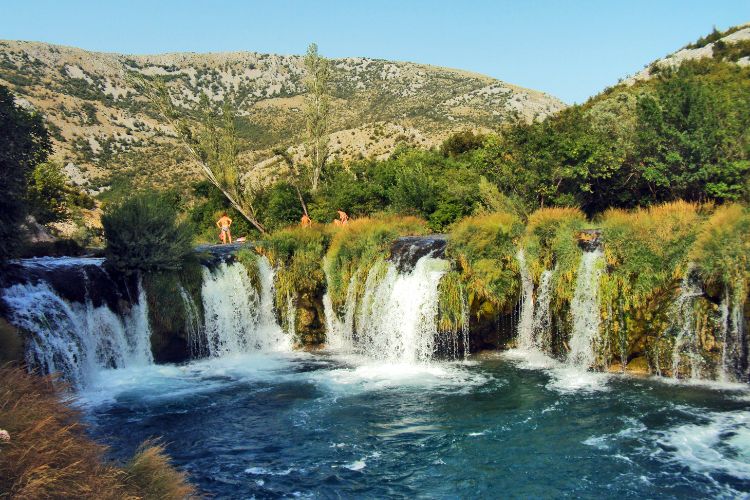
Although not well-known, this is one of Croatia’s most beautiful waterfalls. Located near Šibenik on the fast-flowing Zrmanja river, this area is ideal for rafting and kayaking.
Berberov Buk is surrounded by a green meadow; there are several restaurants; and the clear water of Zrmanja is ideal for swimming. If you’re a good jumper, show off your skills by jumping to Zrmanja from the nearby bridge; it’ll be appreciated.
Just be prepared; Zrmanja is colder than the Adriatic Sea.
Manojlovac, Krka National Park
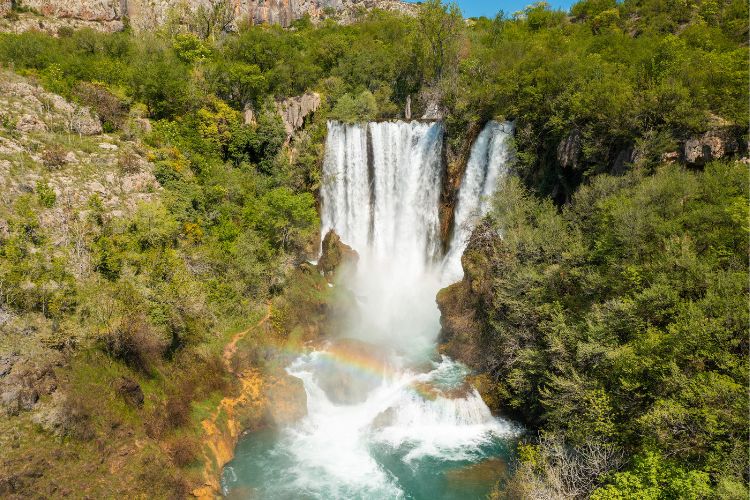
Even most Croats are not aware of its existence, but those who are will claim that it is more beautiful than Skradinski Buk (which many regard as the most beautiful waterfall on the Krka River).
Manojlovac is a beautiful place where the Krka River takes a 180-degree turn. It descends a steep cliff from a height of nearly 60 meters and performs its show for delighted onlookers.
There is a story about how the imperial family admired the beauty of this great waterfall almost 150 years ago: the Austrian emperor and his empress, Elizabeth. Next to the Emperor’s head, a monument to that visit, is a viewpoint to enjoy this hidden gem.
I mean, if it delighted the emperors, surely it will also delight us?
Sopot Waterfall (Central Istria)
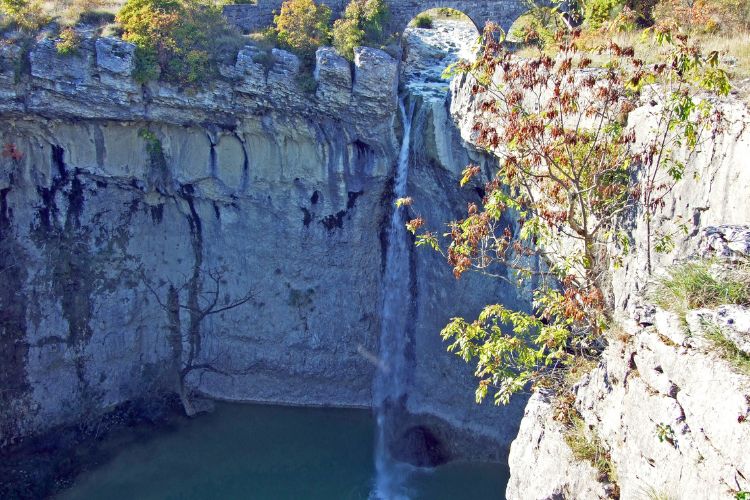
The Sopot Waterfall is truly unique. Especially if you carefully descend to the turquoise lake and find yourself surrounded by towering rock formations.
Sopot Waterfall is a place where refreshing drops of water flow under the old Napoleonic bridge and fall into the turquoise lake from a 25-meter height.
Also, keep in mind that it would be ideal to visit it in the spring or autumn, when the water flow is stronger. Given that Croatia’s summers are extremely hot and have little rainfall, some places like this in Istria may dry up during that time (such as Kotli, which I mentioned earlier).
Roški Waterfall (Roški Slap), Krka National Park
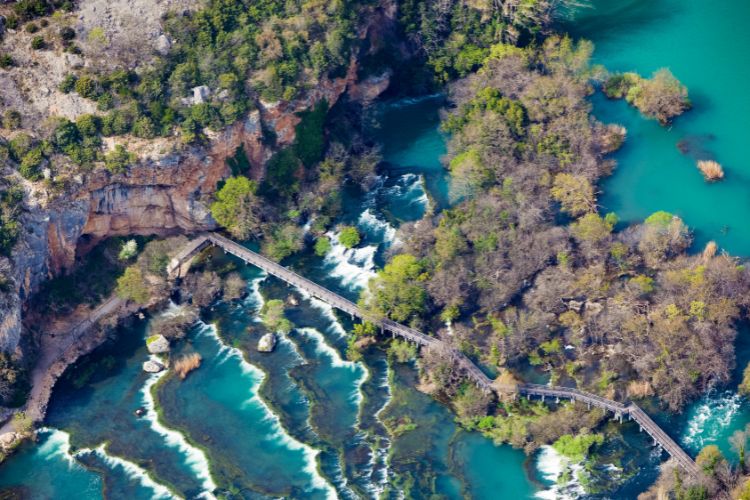
Roški Slap is also in Krka National Park. It is near popular Adriatic destinations such as Split, Zadar and Šibenik.
If you’re in Dalmatia, don’t miss out on this park, which is very similar to Plitvice Lakes National Park.
Roški Waterfall is approximately 650 meters long, up to 450 meters wide, and 15 meters high. The Krka River does not rush here; it appears to have accepted the Dalmatian rule “pomalo,” which means “take it easy.”
Zarečki Krov
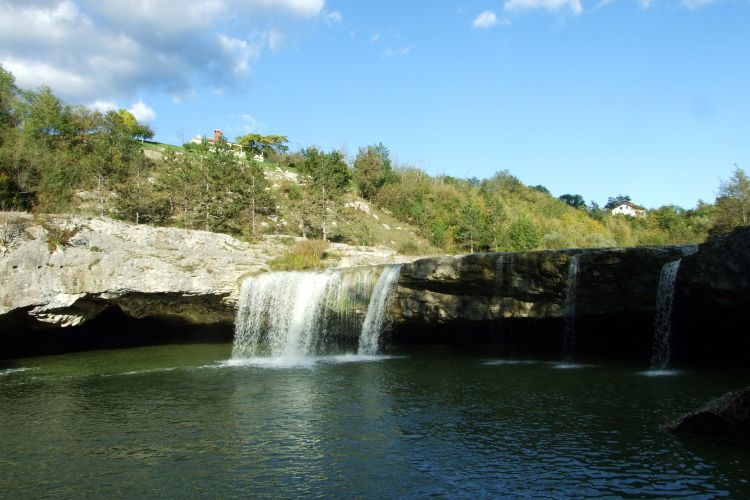
It’s no secret that the most beautiful places are often hidden and the Istrian people also kept Zarečki Krov hidden for themselves. It is a place where water flows into the lake from ten-meter-high rocks.
To reach Zarečki Krov, you must take the old road from Pazin to Cerovlje. Then, you’ll see the macadam road, which is usually avoided.
However, just a hundred meters later, you’ll come across a spot where locals relax and escape the summer crowds. It’s also an ideal location for recreational activities such as diving, fishing, water polo and rock climbing.
And as night falls, they return to their homes along the old road, keeping this hidden gem a secret. So never tell them who told you about this.
There are numerous other waterfalls in Croatia that are well worth seeing, including the Gubavica Waterfall (near Split), the Mali Buk, the Butori Ponor Waterfalls, the Gologoricki Dol Waterfalls near Cerovlje (Istria) and the Mrežnica River Waterfalls.
Whatever you choose, I’m sure that a day spent in unspoiled nature and surrounded by the clear water of Croatia’s waterfalls will be a truly rewarding experience.
Inspire your next adventure with our articles below:
Want to discover more hidden gems and helpful travel tips? Join our free newsletter for the latest travel secrets and travel articles.
We are reader-supported and may earn a commission on purchases made through links in this article.
- From Gaudí to Granada: 16 Incredible Things to Do in Spain - June 27, 2025
- From Pink Sand to Black Volcanic Shores: Europe’s Most Breathtaking Beaches - June 25, 2025
- How to Find Cheap Flights: 11 Expert Tips for Budget Travelers - June 12, 2025

